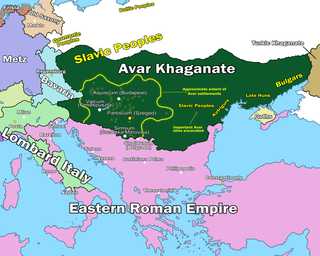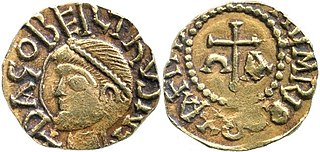The history of Slovakia dates back to the findings of ancient human artifacts. This article shows the history of the country from prehistory to the present day.

The Pannonian Avars were an alliance of several groups of Eurasian nomads of various origins. The peoples were also known as the Obri in chronicles of Rus, the Abaroi or Varchonitai, or Pseudo-Avars in Byzantine sources, and the Apar to the Göktürks. They established the Avar Khaganate, which spanned the Pannonian Basin and considerable areas of Central and Eastern Europe from the late 6th to the early 9th century.

Dagobert I was King of the Franks. He ruled Austrasia (623–634) and Neustria and Burgundy (629–639). He has been described as the last king of the Merovingian dynasty to wield real royal power. Dagobert was the first Frankish king to be buried in the royal tombs at the Basilica of Saint-Denis.

Carantania, also known as Carentania, was a Slavic principality that emerged in the second half of the 7th century, in the territory of present-day southern Austria and north-eastern Slovenia. It was the predecessor of the March of Carinthia, created within the Carolingian Empire in 889.

Great Moravia, or simply Moravia, was the first major state that was predominantly West Slavic to emerge in the area of Central Europe, possibly including territories which are today part of the Czech Republic, Slovakia, Hungary, Austria, Germany, Poland, Romania, Croatia, Serbia, Ukraine and Slovenia. The formations preceding it in these territories were the Samo's tribal union and the Pannonian Avar state.

Samo founded the first recorded political union of Slavic tribes, known as Samo's Empire, ruling from 623 until his death in 658. According to Fredegarius, the only contemporary source, Samo was a Frankish merchant who unified several Slavic tribes against robber raids and violence by nearby settled Avars, showing such bravery and command skills in battle that he was elected "King of the Slavs". In 631, Samo successfully defended his realm against the Frankish Kingdom in the three-day Battle of Wogastisburg.

Alcek or Alzeco was allegedly a son of Kubrat and led the Bulgars to Ravenna that later settled in the villages of Gallo Matese, Sepino, Boiano and Isernia in the Matese mountains of southern Italy.

Dervan or Derwan was an early duke of the Sorbs.
According to the contemporary Chronicle of Fredegar, the Battle of Wogastisburg took place between Slavs under King Samo and Franks under King Dagobert I in 631 or 632. The Frankish armies advanced into the area of the Slavic tribal union in three groups - Alamanni, Lombards, and Austrasian Franks. The first two were quite successful, but the main fighting force was defeated in a three-day siege near a place referred to as Wogastisburg.

The West Slavs are Slavic peoples who speak the West Slavic languages. They separated from the common Slavic group around the 7th century, and established independent polities in Central Europe by the 8th to 9th centuries. The West Slavic languages diversified into their historically attested forms over the 10th to 14th centuries.

Mojmir I, Moimir I or Moymir I was the first known ruler of the Moravian Slavs (820s/830s–846) and eponym of the House of Mojmir. In modern scholarship, the creation of the early medieval state known as Great Moravia is attributed either to his or to his successors' expansionist policy. He was deposed in 846 by Louis the German, king of East Francia.

The Principality of Nitra, also known as the Duchy of Nitra, was a West Slavic polity encompassing a group of settlements that developed in the 9th century around Nitra, in present-day Slovakia. Its history remains uncertain because of a lack of contemporary sources. The territory's status is subject to scholarly debate: some modern historians describe it as an independent polity that was annexed either around 833 or 870 by the Principality of Moravia, while others say that it was under the influence of the neighbouring West Slavs from Moravia from its inception.
Radulf was the Duke of Thuringia from 632 or 633 until his death after 642.
The settlement of the Eastern Alps region by early Slavs took place during the 6th to 8th centuries. It is part of the southward expansion of the early Slavs which would result in the characterization of the South Slavic group, and would ultimately result in the ethnogenesis of present-day Slovenes. The Eastern Alpine territories concerned comprise modern-day Slovenia, Eastern Friuli, in modern-day Northeast Italy, and large parts of modern-day Austria.
Valuk was the slavic duke in the independent land of the Alpine Slavs or Carantania. The date of his reign is around 631. His name is more or less identical to the name of the Prince Valtunka, which can both be interpreted as government or ruler.

Early Slavs settled in the eastern and southern parts of the former Roman province of Pannonia. The term Lower Pannonia was used to designate those areas of the Pannonian plain that lie to the east and south of the river Rába, with the division into Upper and Lower inherited from the Roman terminology.

The Sorbs, also known as Serbs or White Serbs in Serbian historiography, were an Early Slavic tribe settled between Saale-Elbe valley up to Lusatian Neisse. They were part of the Polabian Slavs and Wends group of Early Slavs. In the 7th century, the tribe joined Samo's Empire and part of them emigrated from their homeland White Serbia to the Southeast Europe. The tribe is last mentioned in the late 10th century, but its descendants can be found among Germanized people of Saxony and Slavic ethnic group of Sorbs in Lusatia, and Serbs in Southeastern Europe.
Alternative theories of the location of Great Moravia propose that the core territory of "Great Moravia", a 9th-century Slavic polity, was not located in the region of the northern Morava River. Moravia emerged after the fall of the Avar Khaganate in the early 9th century. It flourished during the reign of Svatopluk I in the second half of the century, but collapsed in the first decade of the 10th century. "Great Moravia" was regarded as an archetype of Czechoslovakia, the common state of the Czechs and Slovaks, in the 20th century, and its legacy is mentioned in the preamble to the Constitution of Slovakia.
Praedenecenti was an early medieval Slavic tribe, mentioned only in the Royal Frankish Annals in 822 and 824. They lived in the buffer zone between the Carolingian and Bulgarian empires. The Royal Frankish Annals associated them with the Abodriti, while modern scholars have also connected them to other Slavic tribes, especially the Braničevci or Merehani. The Praedenecenti sought assistance from the Franks against the Bulgars, but they obviously lost their independence because they were not mentioned after 824.

The Avar Wars were fought between Francia and the Avar Khaganate in Central Europe from 788 to 803, and ended with the Frankish conquest of the khaganate's western regions. The first conflicts between the Avars and the Franks occurred in the 560s, shortly before the Avar conquest of the Pannonian Basin. Armed conflicts between the two powers were not unusual during the following centuries.













